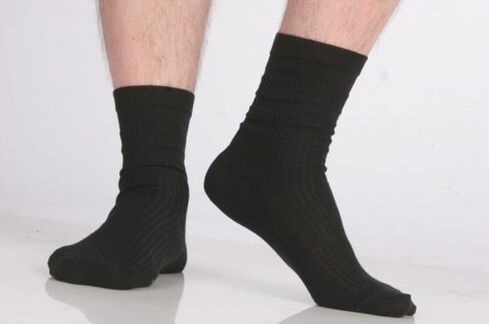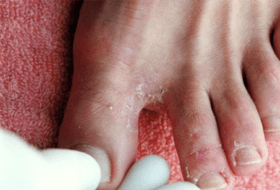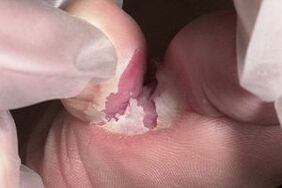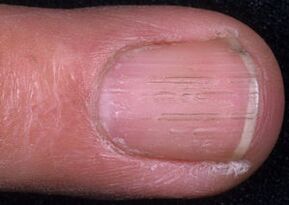Foot fungus is a skin disease characterized by the active reproduction of certain fungi in the epidermis. Today, older adults and children with weakened immune systems are susceptible to the disease. Signs of leg fungus depend on the type of pathogen of the infection process and the volume of feet and nails affected, and vary somewhat at different stages, indicating the progression of the infection. You should know how to identify fungus on your feet, which will allow you to start treatment in time and stop it from developing further.

symptoms of disease
The main site for fungal growth in the legs is usually the area between the toes. This pathology is accompanied by symptoms such as epidermal burning, severe itching and redness. In addition, one can observe cracked and flaky skin, as well as the formation of blisters on the legs and increased dryness of the dermis.
The same symptoms of leg fungus can occur on the soles of shoes with hyperkeratosis of the skin. The insidious aspect of this disease is that, over the course of its course, a difficult-to-treat fungus can develop on the legs and the wound itself is in a state of reinfection.
How to identify fungus on the legs and what symptoms can predict the development of the disease? The first sign of the disease is the appearance of small scales, which are peelings of various types, ranging from small pityriasis to large lamellar lamellae. There are different types of fungi that can cause the disease to develop, but they all share the same characteristics:

- In the initial stages of its development, the pathology proceeds without the presence of obvious symptoms. First, the interdigital folds are affected, most commonly between the ring and ring fingers.
- As the fungal disease progresses, both sides of the foot are affected, gradually spreading to the ankles.
- With a fungal infection of the foot, the skin becomes noticeably thicker, cracks and begins to shine.
- The skin becomes too dry and starts to itch. In addition, the epidermis becomes very red and its affected area becomes inflamed.
- The patient began to complain of pain and burning in the feet.
- As the disease transitions to a neglected form, blisters begin to appear on the skin. When they are turned on, the affected skin area becomes very moist and softened.
There are several forms of foot fungus, each with the development of certain symptoms.
pathological form
Experts have determined that the following types of fungus can affect the skin of the legs:
- interdigitated;
- hyperkeratosis (moccasins);
- sweaty.
The most common form of interdigital fungus on the feet is the interdigital fungus, which is characterized by the appearance of certain signs:
- Most of the time, the area of the fourth and fifth toes becomes where this form of fungus locates.
- As the disease progresses, the skin develops a characteristic scaly appearance and may crack severely;
- A weeping crack or funnel forms between 3, 4, and 5 surrounded by white or green dry skin scales.

Interdigital fungal skin lesions can be dry or wet. If moist interdental fungus is detected, the skin will look swollen. For dry lesions of the epidermis, exfoliation and exfoliation are noted.
The first sign of moccasin-like foot fungus is pain, which is observed in the foot. As the pathology progressed, a gradual thickening of the sole skin was observed, leading to the formation of cracks.
This fungal disease of the legs is considered the most difficult and overlooked, but easy to identify. Fungal diseases can manifest as failure of the nail plates, in which case they acquire a characteristic thickening, are prone to chipping, and may even fall off completely.
The vesicular form of the fungus is characterized by the formation of blisters with a clear fluid inside. Gradually, these blisters mature, become cloudy and open, leading to the formation of erosions of various sizes. The primary location of the bubbles is in the area near the toes of the sole, but they may develop a rash on moccasins.
The vesicular form of the fungal disease is considered very rare but easier to treat. This is because the vesicle becomes a localization site for the pathogen, that is, it does not penetrate deeper into the skin. When a viral or fungal infection adheres to vesicular mycosis, severe skin damage is observed and treatment becomes difficult.
Experts distinguish an erasing form of leg fungus in which all symptoms are indistinct. Diagnosing this pathology is very problematic, as the affected skin looks like a simple untidy leg. In patients with this foot mycosis, symptoms are yellowing of the nails and peeling feet, but they are so mild that the patient does not notice them.
The fungus that is wiped away proceeds in waves, that is, it becomes more severe in the hot season, and in winter it almost completely disappears. With any weakening of the immune system, a sharp exacerbation of the disease is observed, which makes the treatment of foot fungus difficult.
How to identify onychomycosis?
Signs of nail fungus can vary widely at different stages, indicating the progression of the infection. How does toenail fungus start and what signs should I look out for?

- In the first stage, the lesions have no characteristic symptoms, with barely noticeable streaks and spots on the nails. If you ignore the first signs of the disease and start getting a fungal infection, pus may build up in the pericycular area. The result of this pathological process is gangrene or lower extremity amputation.
- With secondary mycosis, the natural shine on the nails disappears. Gradually, the nails become discolored and white and brown streaks form on them. The upper part of the nail and its side parts may be deformed. Advanced features of bacterial nail damage are increased cuticle fragility, delamination, and inflammation. The pathology continues to develop and spread to other nails and feet.
- In the third stage of onychomycosis, the nails turn yellow or dirty brown. Also, it becomes too loose, thickens and lags behind the nail bed. Often, when the shoes are put on, severe pain begins and the itching of the skin becomes unbearable.
There are several types of fungal infections of toenails, each of which can lead to certain symptoms.
- Hypertrophic onychomycosis is accompanied by thickening of the nails and yellow staining. Nails chip easily and thickened cuticles can be seen underneath.
- Atrophic onychomycosis causes thinning of the nails and their destruction, and keratinized skin can be seen underneath.
- Onychomycosis usually does not develop as a stand-alone disease when affected by a moldy fungus, but develops in the context of other diseases.
Nails can be dyed yellow, brown, green or black. Complications usually develop in the form of inflammation of the periungual bed with the release of pus.
Preventive Pathology

With the immune system functioning properly, nail fungus is less likely to start developing after an infection because the body can deal with it on its own. If the fungal infection still affects the feet and nails, then effective treatment is necessary. The sooner the fight against the disease begins, the better the patient's chances of a full recovery.
The fight against foot fungus is considered a rather laborious process, making it easier to prevent the development of the disease. For this, the following precautions must be observed:
- keep your feet dry;
- don't wear other people's shoes;
- Choose socks made of cotton;
- Don't run barefoot on the beach.
You should contact a specialist at the first signs of fungus on your legs. It is important to identify the pathology at the very beginning of its development and prevent further development, which will help avoid many complications. To find out how to identify fungus on your legs, you need to consult a dermatologist.

























